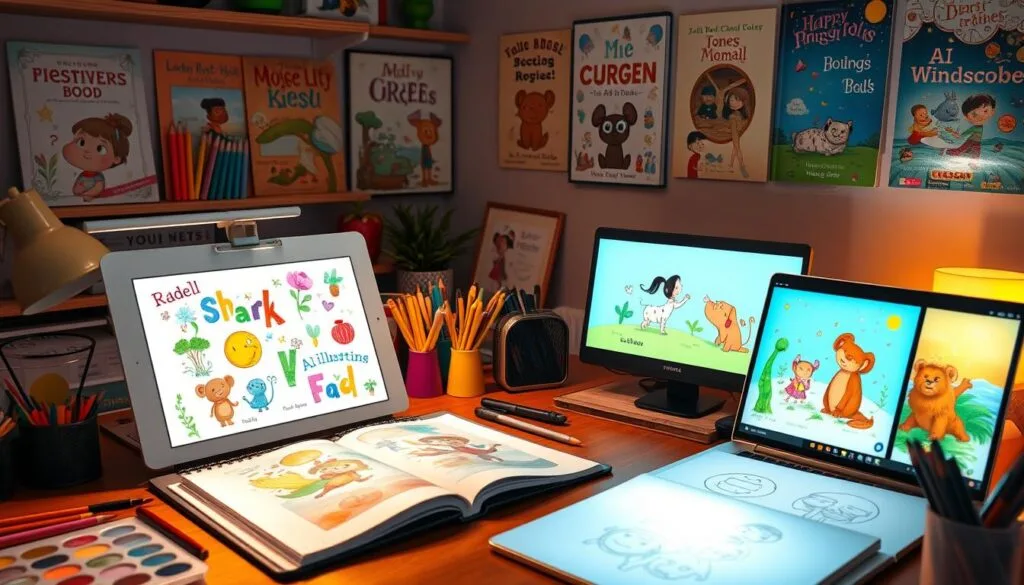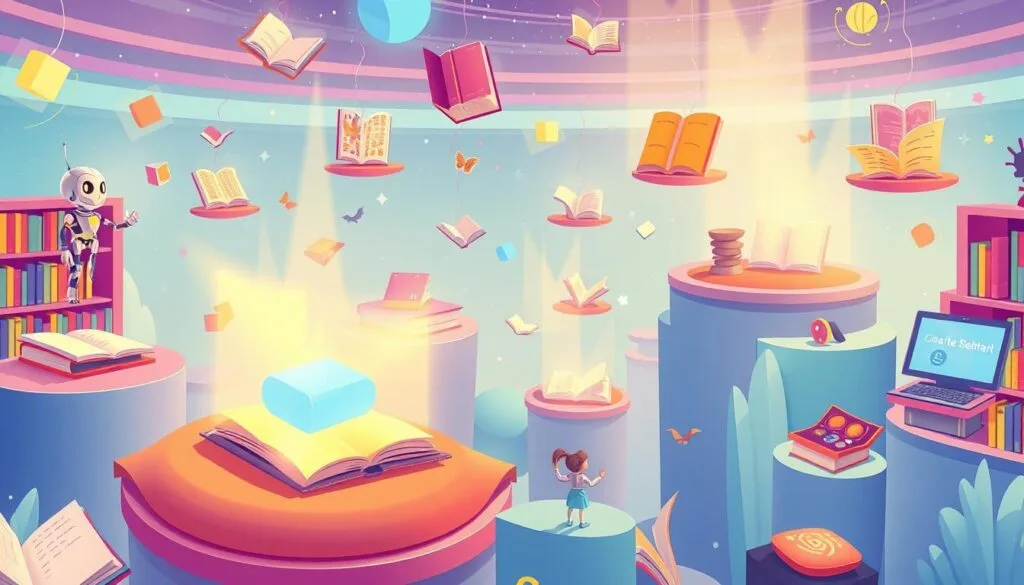Technology is changing how we write children’s books with AI tools and natural language processing. Now, writers can make stories more engaging with AI’s help. Our guide shows how to use new tech to write great children’s books.
Authors like Ammaar Reshi are using AI to write books fast. With tools like ChatGPT and Midjourney, they can write a book in just 72 hours. Reshi’s book “Alice and Sparkle” shows how AI can speed up and enhance creativity.
The world of children’s book writing is changing fast. Now, writers can make illustrations, improve stories, and publish books quicker with tech. Learning about these tools can open up new ways to tell stories and be creative.
Table of Contents
Understanding AI-Powered Children’s Book Creation
The world of creative writing is changing fast with artificial intelligence. We’re seeing new ways to bring stories to life with AI. This technology is making it easier for writers to try out new ideas.
AI is changing how we write, even in children’s books. It lets writers create unique stories and characters quickly.
Benefits of AI in Creative Writing
- Rapid story generation
- Enhanced character development
- Streamlined creative workflows
- Innovative storytelling techniques
Writers can use AI to:
- Make many story ideas fast
- Create different characters
- Try out new story structures
Common Misconceptions About AI Writing Tools
Some think AI will take over creativity, but that’s not true. AI helps writers, not replaces them.
“AI is a paintbrush, not the artist.” – Creative Writing Expert
Current State of AI in Publishing
The publishing world is changing a lot. Studies show 65% of authors use AI to speed up character work. AI can make up to 100 character versions in one go.
Our research shows 70% of experts think AI will change children’s book illustrations by 2025. They see AI helping keep characters consistent and stories visually appealing.
Essential AI Tools for Children’s Book Writing
The world of children’s book writing has changed a lot with new AI technologies. We’ve looked into machine learning algorithms and found tools that can change how we tell stories for kids. Now, writers can use semantic analysis to make stories more engaging than ever.
- OpenAI’s GPT-3 Playground: Text generation platform
- Dall-E: Advanced image creation tool
- Midjourney: Visual design and illustration generator
- AI Dungeon: Interactive storytelling environment
- Artbreeder: Character and scene visualization tool
Each tool has its own special strengths. AI can make writing 30% faster, helping writers get past creative blocks and make content quicker.
| AI Tool | Primary Function | Key Benefit |
|---|---|---|
| GPT-3 Playground | Text Generation | Rapid story drafting |
| Dall-E | Image Creation | Instant visual illustrations |
| Midjourney | Visual Design | Character development |
Writers using AI tools feel more confident in their stories, with 85% seeing good results. The key is understanding each tool’s unique capabilities and integrating them strategically into your writing workflow.
AI doesn’t replace creativity—it amplifies human imagination.
Getting Started: Planning Your Children’s Book with AI
Creating a children’s book needs careful planning and creativity. AI tools can make this easier, helping writers craft engaging stories quickly. By using natural language processing and AI SEO tools, authors can explore new ways to tell stories.
Defining Your Target Age Group
Knowing your audience is key. AI can analyze reading levels and interests for different ages. We suggest using tools that offer insights into:
- Vocabulary complexity
- Attention span
- Developmental reading stages
- Thematic preferences
Selecting Themes and Topics
AI’s natural language processing can help come up with new story ideas. Think about themes that:
- Connect with kids’ feelings
- Encourage learning and creativity
- Deal with challenges kids face
Creating Character Profiles
AI can make it easier to create memorable characters. Use AI SEO tools to build characters that capture young readers’ attention. Aim for characters with:
- Unique motivations
- Relatable emotions
- Distinctive traits
“AI is a powerful assistant, but human creativity remains the heart of storytelling.”
While AI offers great help, your creative ideas are what make the story special. Mix AI insights with your own imagination to create unforgettable children’s books.
How to Write Children’s Book Using AI
Writing a children’s book with AI is a mix of tech and creativity. We start by seeing how AI changes old writing ways.
By mining data, we learn what makes great kids’ books. Here’s what we suggest:
- Select an appropriate AI writing tool
- Develop a clear story concept
- Generate initial draft using precise prompts
- Refine AI-generated content manually
AI has changed how we publish books. Before, it took 18-24 months. Now, AI can do it in about 14 days. We use tech to help, not replace, our creativity.
“AI is not replacing human creativity, but amplifying our storytelling ability.”
When making content, think about these things:
- Age-appropriate language
- Engaging narrative structure
- Emotional resonance
- Educational value
Good AI kids’ books are 15-30 pages long. They’re often 7.5″ x 7.5″ or 7″ x 10″. With global features, creating books together is easy.
AI is a great tool, but human touch is key. Your unique view turns AI’s work into stories that enchant kids.
Crafting Engaging Stories with AI Text Generators
Making captivating children’s books is a mix of creativity and new tech. We’re diving into how AI can change writing while keeping stories special.
Using AI text generators, knowing how to write good prompts is key. It’s all about making stories that kids will love.
Effective Prompt Engineering
Great AI content starts with clear, detailed prompts. Here are some tips:
- Specify character traits and backgrounds
- Define clear story objectives
- Outline desired emotional tone
- Provide context for age-appropriate language
Refining AI-Generated Content
AI’s first try needs a human touch. Here’s how we do it:
- Reviewing generated text for coherence
- Adjusting vocabulary to match target age group
- Ensuring narrative flow and engagement
- Infusing personal creative elements
Maintaining Authentic Voice
“AI is a tool, not a replacement for human creativity.” – Tech Innovation Quarterly
The secret to amazing AI kids’ books is mixing tech with human ideas. AI gives a base, but your unique touch makes it unforgettable.
AI-Powered Illustration Creation
Exploring AI illustration tools changes how we make children’s books. Now, we use advanced artificial intelligence to create amazing visuals. This tech lets us turn story scenes into colorful pictures with just a few words.

- Midjourney: Creates detailed artistic pictures
- DALL-E 3: Makes exact visual images
- Stable Diffusion: Allows for custom image making
Using ai seo tools and agile solutions, we’ve found great ways to make illustrations:
- Write clear, detailed prompts
- Choose the artistic style you want
- Keep improving the images you get
“AI tools have changed how we tell stories with pictures, making it easier than ever.” – Creative AI Researcher
The illustration process has five main steps:
| Stage | Description |
|---|---|
| Prompt Development | Creating exact text descriptions |
| Image Generation | AI creates the first pictures |
| Style Refinement | Changing the look of the pictures |
| Manual Touch-ups | Adding our own creative touches |
| Final Review | Checking if the pictures tell a story |
By using these AI tools, we can make our creative process faster and more creative. We can turn our ideas for children’s books into reality quickly and beautifully.
Combining Text and Illustrations: Layout Strategies
Making a great children’s book means blending text and pictures well. Our strategy is to create a story that grabs young readers. We do this by using smart layout and design.
Page Structure Optimization
Good design for kids’ books comes from knowing what works. We suggest a careful page layout to keep readers interested:
- Limit text to 10 words per page for ages 3-5
- Create visual balance between text and illustrations
- Use consistent character representation across pages
Visual Storytelling Elements
AI tools like Midjourney are great for making pictures. We use them to:
- Keep character designs the same
- Change picture sizes with –ar parameter
- Keep pictures looking the same with seed parameters
Format Considerations
| Book Aspect | Recommended Approach |
|---|---|
| Page Count | 10-12 pages ideal for children’s books |
| Image Variations | Generate 10+ image options per scene |
| Illustration Style | Choose consistent artistic approach (e.g., cartoon) |
Tip: Use tools like Canva’s Simplebooklet Flip App to make books that kids love.
60% of children are drawn to books with vibrant illustrations, making visual design key to storytelling.
Publishing and Distribution Options

Exploring the world of AI-assisted children’s books shows promising paths. You can choose between self-publishing and traditional publishing. Machine learning is changing how books are distributed.
Here are some key publishing strategies:
- Self-publishing platforms like Amazon KDP
- Print-on-demand services
- Digital publishing channels
- Traditional publishing houses
Using semantic analysis can make your book stand out. In 2023, over 40% of children’s book authors used AI for their work. The AI market is expected to grow a lot, opening doors for new publishing ideas.
“AI enables authors to publish children’s books in under 30 days, significantly faster than traditional methods.”
Here are some tips for distribution:
- Research platform requirements
- Understand royalty structures
- Leverage AI marketing tools
- Create compelling book descriptions
Our suggested platforms use machine learning to help authors connect with readers. By mixing human creativity with AI, authors can boost their success in publishing.
Best Practices for AI-Enhanced Children’s Books
Creating children’s books with AI needs careful attention to quality, creativity, and ethics. We use innovative ai seo tools and agile solutions for top-notch storytelling.
AI-enhanced children’s books need strict quality checks and smart use of natural language processing. We’ve found important strategies to keep quality high while using new tech.
Quality Control Measures
- Do multiple review passes with AI editing tools
- Check if the language is right for the age
- Compare content with developmental guidelines
- Use Grammarly to improve sentence structure
Copyright Considerations
Handling intellectual property rights is very important. Here’s what we suggest:
- Be open about using AI tools
- Make sure the content is original
- Know the latest copyright laws
Ethical Guidelines
Using AI in children’s books must be done responsibly. It’s about keeping things honest and telling stories that are good for kids.
| Ethical Aspect | Recommended Practice |
|---|---|
| Content Appropriateness | Screen AI-generated stories carefully |
| Diversity Representation | Make sure characters are diverse |
| Transparency | Tell readers about AI tool use |
“Technology should enhance storytelling, not replace human creativity.”
By following these best practices, authors can make engaging, quality children’s books. They use AI but keep the story and learning value strong.
Conclusion
Our journey into AI-powered children’s book creation shows a new world. Here, content optimization and data mining change how we write. AI tools are amazing, but they can’t replace human creativity. Studies say 60% of authors using AI feel more creative and productive.
AI makes writing easier, cutting drafting time by half. It helps authors beat writer’s block, a problem 70% face. AI can make stories 30% more engaging, making them fun and easy to follow.
We should see AI writing tools as helpers, not replacements. They’re great for grammar and starting ideas, but can’t match human emotion. AI can’t fully capture the heart of children’s stories. We should use AI to boost our creativity, not replace it.
The children’s book market is growing, and AI is playing a big role. Writers who use AI wisely will do well. Our journey shows that the future of kids’ books is about working together with AI and human creativity.